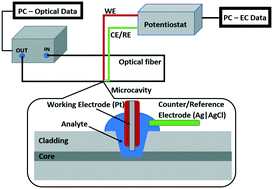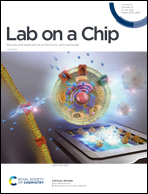Electrochemistry in an optical fiber microcavity – optical monitoring of electrochemical processes in picoliter volumes†
Abstract
In this work, we demonstrate a novel method for multi-domain analysis of properties of analytes in volumes as small as picoliters, combining electrochemistry and optical measurements. A microcavity in-line Mach–Zehnder interferometer (μIMZI) obtained in a standard single-mode optical fiber using femtosecond laser micromachining was able to accommodate a microelectrode and optically monitor electrochemical processes inside the fiber. The interferometer shows exceptional sensitivity to changes in the optical properties of analytes in the microcavity. We show that the optical readout follows the electrochemical reactions. Here, the redox probe (ferrocenedimethanol) undergoing reactions of oxidation and reduction changes the optical properties of the analyte (refractive index and absorbance) that are monitored using the μIMZI. Measurements have been supported by numerical analysis of both optical and electrochemical phenomena. On top of the capability of the approach to perform analysis on a microscale, the difference between oxidized and reduced forms in the near-infrared region can be measured using the μIMZI, which is hardly possible using other optical techniques. The proposed multi-domain concept is a promising approach for highly reliable and ultrasensitive chemo- and biosensing.



 Please wait while we load your content...
Please wait while we load your content...